On the trail of the Bisharat Horses: the Government Stock Farm, Acre, and the Trans-Jordan Frontier Force
The origins of the three horses presented by Shibly Bisharat to King Faruq of Egypt are currently somewhat obscure, as the only information we have at present comes from Shibly’s son Midhat Bisharat’s correspondence with Dr Hans Nagel, which gives their strains and includes the fact that they were purchased from the Trans-Jordan Frontier Force when it was disbanded in 1948. There is no mention of their breeders, and no direct connection to the Bedouin.
Only the stallion Besheir El Ashkar and one of the two mares, Badria, still have descent in horses accepted by the Asil Club and Al Khamsa.
What we know of these two from Pearson and Mol’s 1988 The Arabian Horse Families of Egypt is given below:
Besheir el Ashkar was a chestnut foaled on 26th March, 1935. He was presented to the Inshass Stud by Basharat Bey in March 1948 and sold to the Wasta Farm in October 1951.
p. 59
Badria was a chestnut foaled on 26th March, 1941. She was presented to the Inshass Stud by Basharat Bey in March 1948 and transferred to the Veterinary Section of the Army in June 1953 and later to the EAO.
p. 129
Both horses have an exact date of birth, which suggests that they may have come from a place where keeping a record of the day of foaling was important, such as a civil or military stud. There was a government stud at Acre, which bred horses, and the Trans-Jordan Frontier Force itself had its own breeding scheme. The Acre stud kept records of the date of birth, according to a 1947 document in the Israeli National Archives, which states
(a) Births
Animals born shall be taken on charge on the Animal Stock Records on the day of birth and entered also on the Variation Return.
However, the dates of birth for Besheir El Askhar and Badria are identical, except for the year, which, while it may be a coincidence, may also reflect other administrative priorities. Another possibility is that 26 March is the equivalent of 1 January/1 August for Thoroughbreds, or it may reflect the date of their entry into Inshass, as they would have arrived together in March 1948, following the disbandment of the Trans-Jordan Frontier Force in February.
I have been looking, on and off, for more information on the Trans-Jordan Frontier Force and its horses, for several years. At present, the state of my knowledge is patchy and fragmentary, but there is some potentially useful information that I have gleaned from old British government records.
I give some passages from primary sources below.
The Government Stock Farm at Acre:
The scheme for a central stud farm at Acre with five branch establishments in the districts has materialized. The stock acquired includes three pure-bred Arab stallions of different and | well-known desert strains, entered in the General Stud Book, from the Crabbet Stud in England … Lists of suitable female stock have been prepared and propaganda is being conducted among local stockowners.
REPORT BY HIS BRITANNIC MAJESTY’S GOVERNMENT TO THE COUNCIL OF THE LEAGUE OF NATIONS ON THE ADMINISTRATION OF PALESTINE AND TRANS-JORDAN FOR THE YEAR 1926. p. 46f.
Stock Breeding Service.
The pedigree stock of the Government stud-farm consists of 5 Arab stallions and 3 mares….
The stallions are much in demand; only approved local mares, of which a register is kept, are served. There is no charge for service, but 100 mils is charged for registration.
REPORT by His Britannic Majesty’s Government to the Council of the League of Nations on the Administration of PALESTINE AND TRANS-JORDAN FOR THE YEAR 1927, p. 57f.
ANNEXURE “F”.
REPORT ON THE ACRE STUD FARM FOR THE YEARS 1931 AND 1932 .
In June 1931 Mr. B.M. Cameron was appointed Manager of the Acre Stud Farm and Agricultural Station to replace Brig. General Mc Neill, C.B., C.B.E., D.S.O., retired.
Report of the Department of Agriculture and Forests for the years 1931 & 1932, p. 131.
17. There are 258 animals on the strength of the stud farm of which 26 are bulls, 22 cows, 3 heifer calves, 120 sheep, 50 goats, 6 Arab horses, 14 donkeys and 6 working animals.
p. 132
24. Slow but steady progress in establishing breeding stock at the farm has been made during the past two years, the chief cause being lack of sufficient funds … In the past, most of the funds for purchase of stock was spent on horses
p. 133
ARAB STALLIONS
66. As last year, one of the two Arab stallions was stationed at Safad and the other at Acre.
There was a good demand from Asil (pure-bred) mare owners for the services of these two stallions.
Annual Report of the Department of Agriculture and Forests for the year ending March 1935, p. 60
49. Government Stock Farm, Acre. — Four Guernsey cows, one Arab stallion and one Large White sow were acquired for use at the Stock Farm during the year. 291 animals in all were locally bred on the Farm during the same period. … The Government Arab and West Highland Pony stallions were also made good use of during the season.
REPORT by His Majesty’s Government in the United Kingdom of Great Britain and Northern Ireland to the Council of the League of Nations on the Administration of PALESTINE AND TRANS-JORDAN for the year 1937, p. 271f.
48. Government Stock Farm, Acre. — The establishment of breeding stock at this farm was increased. One Arab stallion, one Arab mare, eight Cyprian mares and jackasses, eighteen cows of the Lebanese breed, and forty-five Damascus goats were acquired during the year.
49. Good use was made of the Government’s Arab and West Highland pony stallions.
REPORT by His Majesty’s Government in the United Kingdom of Great Britain and Northern Ireland to the Council of the League of Nations on the Administration of 1 PALESTINE AND TRANS-JORDAN for the year 1938, p. 283
Arab Horses.
223. The stud of pedigree Arab horses, which is maintained to improve the Arab blood in the country, consists of 6 stallions, 6 brood mares, with 2 colts and 2 filly-foals. The stud has been increased and new blood introduced by the purchase of 2 pedigree stallions from Syria and a mare from Trans-Jordan. The free services are very much appreciated by the Arab horse-breeders, many of whom ride great distances in order to have their mares served by a Government stallion.
Annual Report of the Department of Agriculture and Fisheries for the year ended 31st March, 1938, p. 34
The stud farm at Acre did not have a large enough breeding operation to supply the Trans-Jordan Frontier Force with horses, but it is interesting to note that the three founding stallions came from Crabbet, that the stud sourced its mares locally, and that some of those mares were Arab. Where the Arab mares came from, the reports unfortunately do not say. Note, however, the use of “Asil” in the 1935 report for the local mares coming to the Arab stallions at the stud: were the mares that the Government Stock Farm owned also asil?
It is possible that horses sired by the stallions at the Government Stock Farm were sold to the Trans-Jordan Frontier Force, but at present I have found no evidence for this.
R.J. Cadranell and Michael Bowling have kindly supplied the following details on the three Crabbet stallions that were used at Acre. They were
- Kaimakam/Bersim br 1925 *Nureddin II x *Batla
- Manyana ch 1924 Rafeef x Marhaba
- Raschid II/Rayden lt b 1924 Naufal x Rafina
The Arab Horse Society Stud Book volume 4 (1930) says Kaimakam, Manyana and Rayden were owned by the Government of Palestine, Stud Farm, Acre, Palestine. Volume 5 notes that Kaimakam was gelded in 1931, and that Manyana died the same year of dourine. There are no updates on Rayden. The 1927-1930 government report by the Department of Agriculture and Fisheries says that there was a dourine outbreak in 1929 among the government horses, resulting in the death of two of the stallions; the survivors were gelded.
In the Crabbet herd book, Lady Wentworth states that Rissaal was originally sold in August 1926 to go to Palestine, but that he was exchanged for Manyana. According to the Arab Horse Society Stud Book volume 4, a fourth stallion, Nizam (Crosbie x Rose of Persia) was also exported by the Government of Palestine for the Acre farm; he too was gelded in 1931.
There is one last primary source from the Acre farm that I wish to mention here, a letter in the Israeli National Archives requesting to exchange an Arab colt bred at the farm for a stallion belonging to a Mr Pharaon of Beirut.
DEPARTMENT OF AGRICULTURE AND FISHERIES.
P.O.B. 667
JERUSALEM, PALESTINE.
24th December, 1946.
Chief Secretary.
I would be obliged if authority could be granted for the exchange of an Arab colt, bred on the Government Farm at Acre and aged 1 year and 9 months for an 8-year-old Arab stallion belonging to Mr. Pharaon of Beirut. This horse is the son of one of the best Arab sires in Lebanon and has won 10 races in Beirut.
2. The Arab stallion mentioned above has been examined by the Manager of the Government Farm, Acre, who reported as follows: —
“I have examined the stallion offered and consider that the exchange would be to the advantage of this Station as we require new blood in our Stud and the new horse fulfils all my requirements as to breedings, age, size, etc..
He is also of a heavier type and more likely to breed suitable remounts for the Police.”
[signature]
for DIRECTOR OF AGRICULTURE AND FISHERIES.
Permission was duly granted for the exchange. The letter is of interest inasmuch as it gives insight into the type of horse that the Acre farm sought as breeding stock, with age, size and substance being important. There was some effort made to get horses of a good pedigree, but in the government correspondence at least, the details of the breeding are lacking.
Turning to the Trans-Jordan Frontier Force, a report from 1932 indicates that at this point, remounts were sourced from Syria, due to a lack of local horses suitable for the cavalry.
ANNEXURE “D”.
THE POSITION OF ANIMAL INDUSTRY IN PALESTINE (Memorandum submitted to the Secretary of State for the Colonies in 1932)
7. HORSES — The horse of the country consists of an indifferently bred Arab and is of the riding type. A few are used for draught purposes in the towns and for farm work. Very few locally bred horses of a type suitable to mount the Palestine Police and Trans Jordan Frontier Force are to be found. Remounts for these Forces are purchased mostly in Syria.
Report of the Department of Agriculture and Forests for the years 1931 & 1932, p. 121
What exactly is meant by “an indifferently bred Arab” is left unclear; the reports mention kadish mares, glossed at one point as “impure Arab” (Annual Report of the Department of Agriculture and Forests for the year ending March 1935, p. 71).
The Trans-Jordan Frontier Force also castrated stallions it acquired, starting in 1929/30.
ANNEXURE “B”.
REPORT ON CASTRATION OF 303 ARAB STALLIONS OF THE TRANS-JORDAN FRONTIER FORCE BETWEEN 22ND NOVEMBER 1930 AND MARCH 3RD 1931.
1. On its formation in April, 1926, the Trans-Jordan Frontier Force was based on the principle adopted in Sillidar Corps, each trooper owning his individual horse, purchased as a remount by a Board of Officers, including the Senior Veterinary Officer, the purchase money being advanced by Government to the trooper, and paid back by him in monthly instalments from his pay until the whole amount had been refunded, the horse then becoming the property of the trooper.
2. Owing to all these Arab horses being entire, cases of savagery and riot in the ranks were constantly occurring, and the stallions were incontrollable in the presence of mares; and in addition, in dismounted action, continual fighting occurred between the held horses, with consequent breaking loose from the horse holder holding four horses. Again, when picketed out in open lines, cases were frequent of horses drawing picketing gear, bolting through the lines, savaging other horses, and causing injury both to themselves and other horses from the picketing peg attached to the leg; castration was therefore decided upon.
3. However, before Government would give permission for wholesale castration, a limited number, 30 stallions of all ages up to 14 years old, were castrated during the winter of 1929 and 1930 as a test, by the Senior Veterinary Officer, Trans-Jordan Frontier Force, with good results. From this experiment, Government then decided:
1. To effect the purchase of horses of Headquarters and two Squadrons.
2. Castration of all horses purchased.
3. To castrate such of the privately owned horses remaining on the strength of the Force whose owners were willing for this to be done, on the following conditions:
(a) If the animal died or became useless by reason of the operation, Government will stand the loss, and
(b) When the owner takes his discharge, Government will purchase the animal for re-allotment at a valuation fixed by a Board of Officers, provided the animal is passed as fit for service at that time.
4. For the purposes of valuation and purchase, an independent Board, composed of the Chief Veterinary Officer, Government of Palestine, and Manager of the Government Stud Farm, Acre, Palestine, were appointed to pass animals as suitable for purchase by the Government and a price set on them.
Out of a strength of some 470 stallions, 320 were so purchased by Government, with authority to castrate.
Report of the Department of Agriculture and Forests for the years 1931 & 1932, p. 116
A notable point here is the fact that privately-owned horses were only castrated if their owners agreed to it, so, based on the evidence at hand, it is possible for a stallion to have come from the Trans-Jordan Frontier Force.
Also of interest is the fact that the manager of the Acre farm was on the board that evaluated horses for purchase by the British administration for the Trans-Jordan Frontier Force. There was therefore a connection between the Government Stock Farm, which bred Arab horses, and the horses supplied to the Trans-Jordan Frontier Force.
The Trans-Jordan Frontier Force ran its own breeding scheme, in addition to buying adult horses as remounts.
At the request of the Senior Veterinary Officer, Trans-Jordan Frontier Force, blood samples of mares selected for breeding to the District Stud Stallion of the Force in Trans-Jordan were tested for possible infection with Dourine by the Government Veterinary Laboratory.
Annual Report of the Dept. of Agriculture and Fisheries, 1934, p. 94
In 1934 there was a stallion which belonged to the Trans-Jordan Frontier Force. There is no mention made of mares, however, nor where the stallion came from. Was he originally sourced from Acre? Was he bought locally? In Syria? The report simply does not have that information.
In 1936, it would appear that the Force began to breed horses.
28. In connection with a horse-breeding scheme initiated during the year, the Force now possesses:
2 thoroughbred Arab stallions purchased in September at Hama in Syria;
3 countrybred stallions purchased in Trans-Jordan;
9 specially selected mares, purchased in Trans-Jordan (as remounts).
The mares have been posted to squadrons, and in the nonbreeding seasons do ordinary troop work.
Three stallions are with squadrons, and the two thoroughbreds are at Zerka.
REPORT by His Majesty’s Government in the United Kingdom of Great Britain and Northern Ireland to the Council of the League of Nations on the Administration of PALESTINE AND TRANS-JORDAN for the year 1936, p. 124
26. Horse Breeding Scheme. — The Force now possesses
4 thoroughbred Arab Stallions;
4 countrybred Arab Stallions purchased in Trans-Jordan (as remounts);
9 specially selected mares purchased in Trans-Jordan (as remounts).
As in previous years, the countrybred stud stallions and mares have been with squadrons doing ordinary troop work.
The Breeding Scheme has become popular, and constant demands are being made by the Mukhtars of villages for horses to stand at stud.
REPORT by His Majesty’s Government in the United Kingdom of Great Britain and Northern Ireland to the Council of the League of Nations on the Administration of PALESTINE AND TRANS-JORDAN for the year 1937, p. 113
32. The animal strength on 31st December, 1938, was four hundred and seventy-four horses and eleven mules. During the year, 79 remounts were purchased in Trans-Jordan and Palestine, the average price paid was £P.27. The health of the horses has been good throughout the year.
33. Horse Breeding Scheme. — The Force now possesses
Three thoroughbred Arab stallions;
Four country-bred Arab stallions;
Nine specially selected mares;
Sixteen Yearlings.
As in previous years, the country-bred stallions and mares have been with squadrons doing ordinary troop work.
During the year, 300 mares belonging to the Arab Legion, civilians and tribes, were served.
The popularity of the breeding scheme continues, and demands by Mukhtars of villages and Sheiks of tribes for horses to stand at stud are increasing.
REPORT by His Majesty’s Government in the United Kingdom of Great Britain and Northern Ireland to the Council of the League of Nations on the Administration of 1 PALESTINE AND TRANS-JORDAN for the year 1938, p. 117
The Trans-Jordan Frontier Force’s own breeding stock is another potential source for the Bisharat horses. Given the apparent inception of the programme in 1936, however, Besheir El Ashkar would not have been bred by the Force. As a yearling, he would presumably have been too young to have been one of the foundation stallions, though the Acre farm imported Kaimakam as a two-year-old, so it is not impossible. Badria’s year of birth, in 1941, would agree with her possibly being the product of the Force’s breeding scheme.
Regarding the Force’s breeding stock, two of these stallions were from Syria and are “thoroughbred”, i.e. probably asil, while the other four were “country-bred”, so probably not asil. The Syrian stallions were reserved for stud duties only, and stood at Zarqa, while the country-bred stallions, like the mares, were out with the cavalry squadrons.
The mares are not described as Arab, but rather as “specially selected” local mares; their primary function appears to have been riding horses. I am not sure how the breeding scheme starts out with nine mares in 1936 and has sixteen yearlings in 1938; that mathematics does not work, so there were presumably more mares which are not accounted for in these reports. It is also possible that the Force bought yearlings in 1938, though I would have expected some indication of their origin to be given in that case, whether thoroughbred, country-bred or specially selected.
The fragments of information from the British government reports do not provide us with new knowledge about Besheir El Ashkar and Badria specifically. However, I think that they may provide launching points for further research into the background of these two horses. The records of the Government Stock Farm at Acre and the Trans-Jordan Frontier Force’s own breeding programme are certainly worth investigating, to see whether either programme produced horses that match the details we have of Besheir El Ashkar and Badria. It would also be interesting to learn whether the Trans-Jordan Frontier Force had hujaj or some other form of pedigree information for their two “thoroughbred Arab” foundation stallions from Syria.
To finish, below are photos of horses at the Government Stock Farm, Acre, and of horse from the Trans-Jordan Frontier Force.
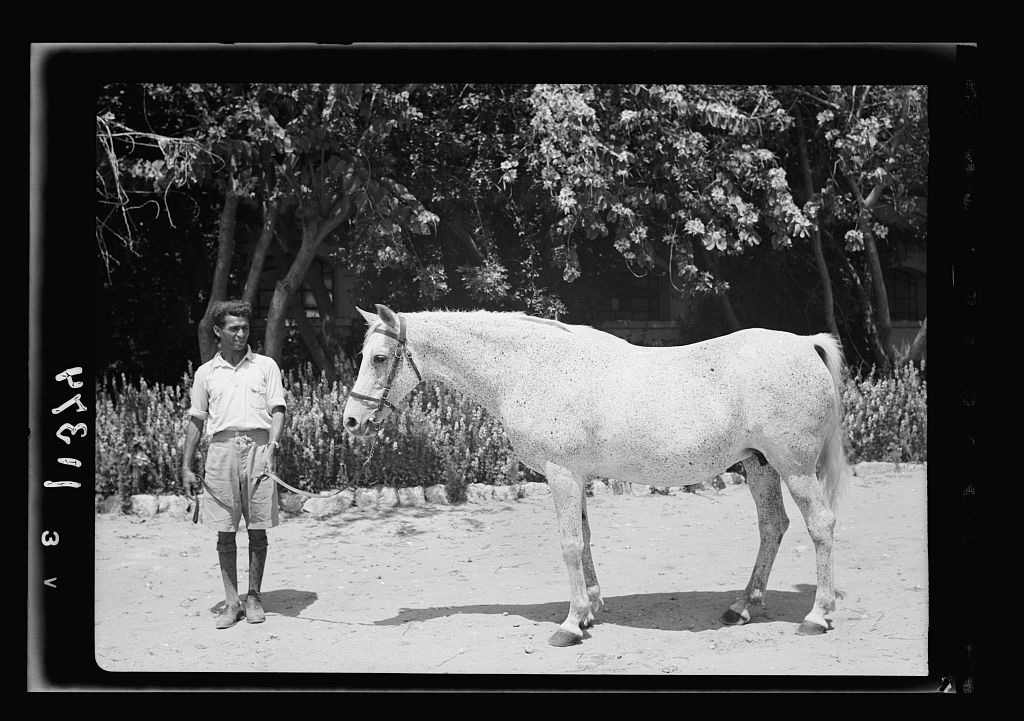
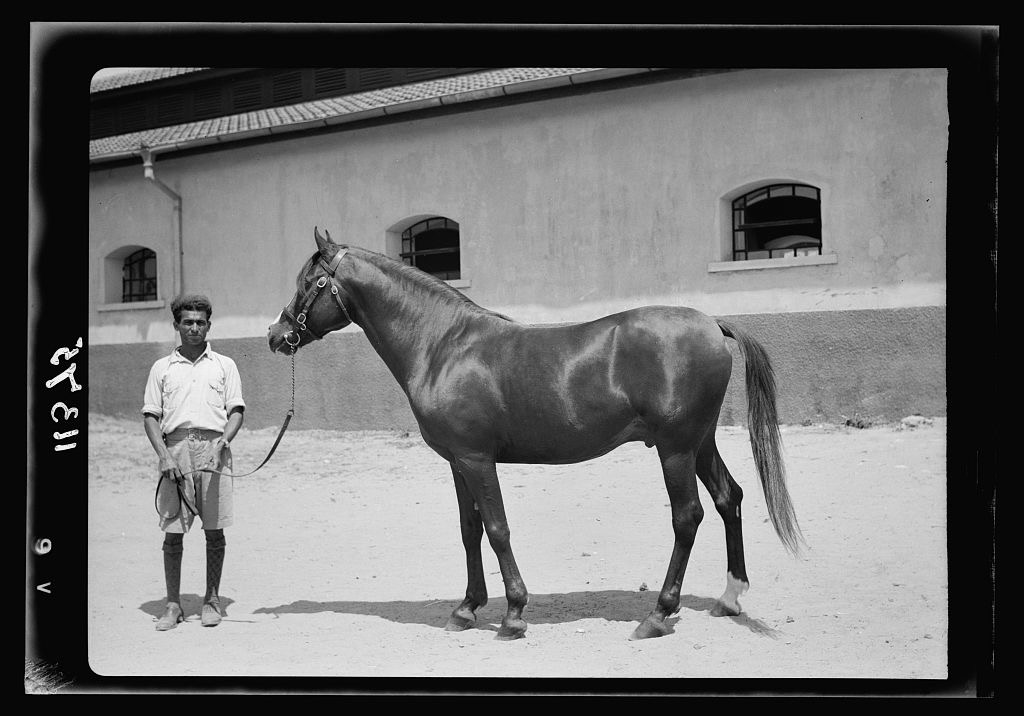
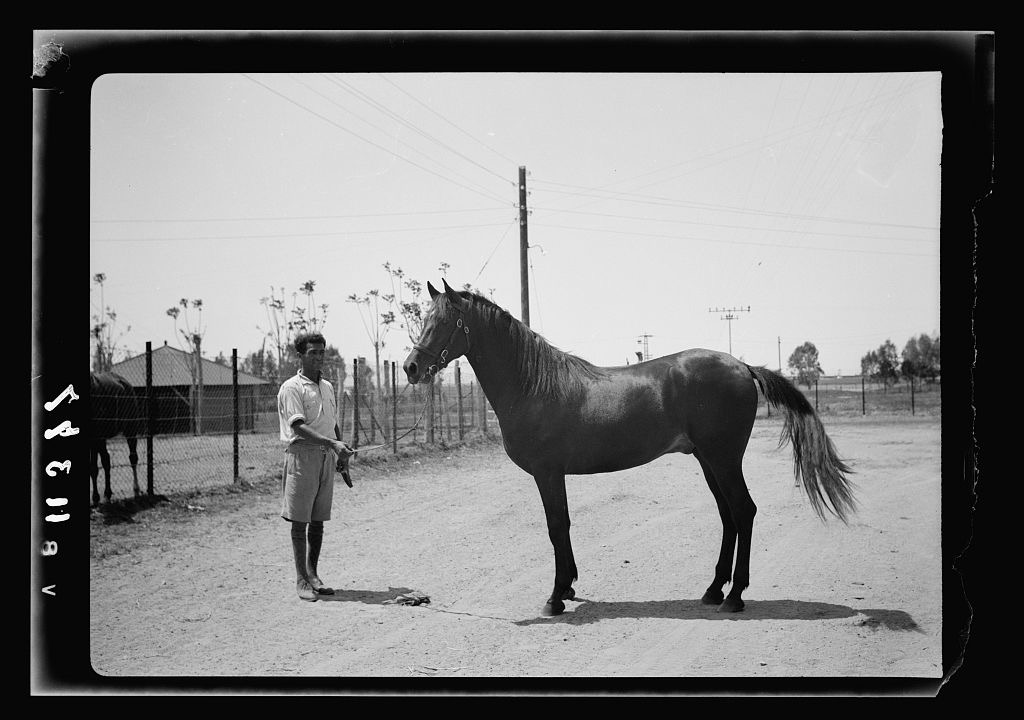

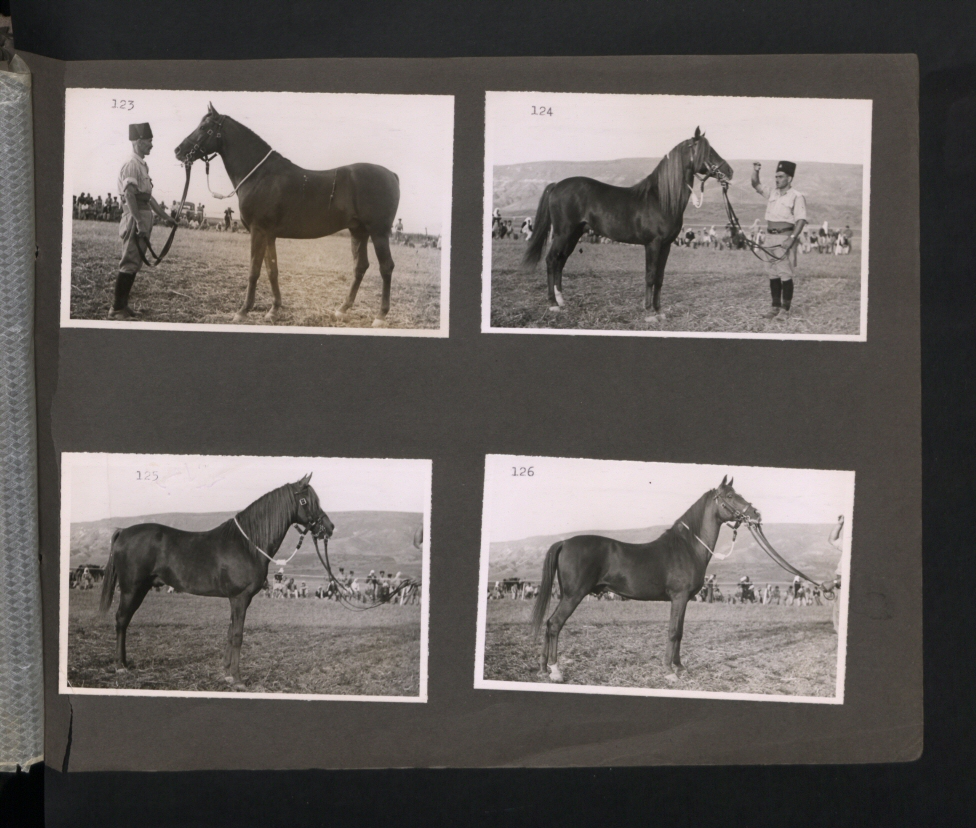
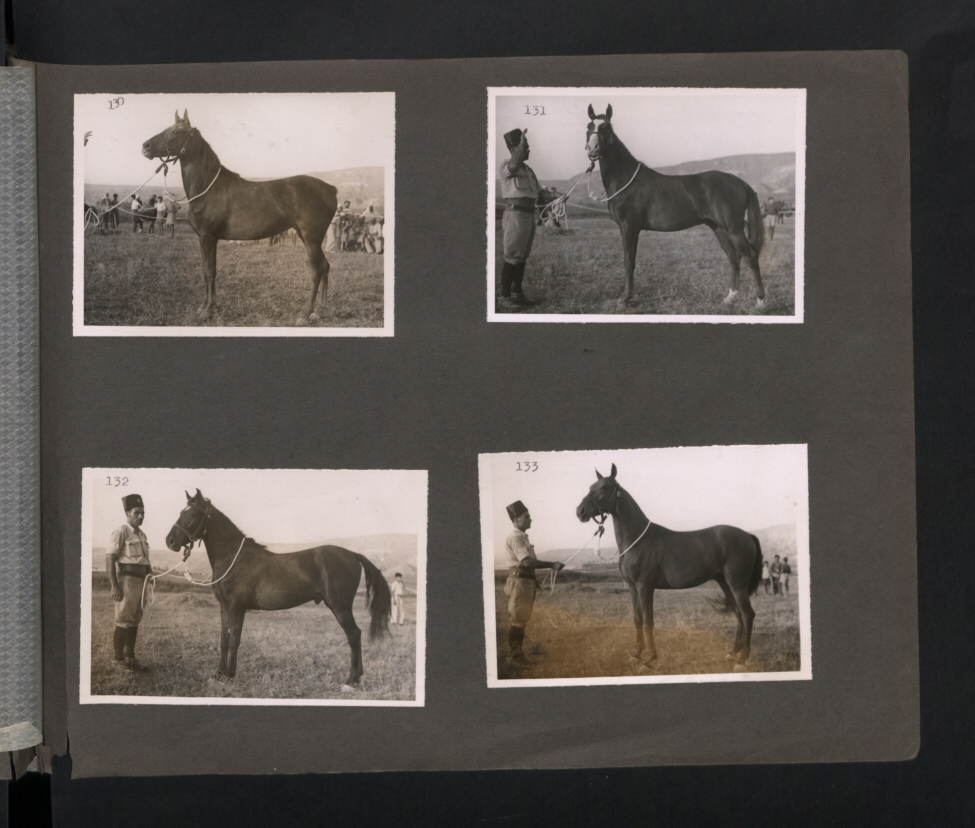
The penultimate panel shows four photos of stallions of distinct Arab type, unlike the rest of the panels.
Yes, those are quite nice horses in that second-last TJFF image. 126 in particular is shown to his advantage, looking towards the camera with pricked ears as he is.
Regarding the same birthday of the Bisherat horses given by Inshass: In my opinion it was the normal use with many acquired horses at Inshass that their birthday was the very day the horse came to Inshass, therefore bothe Badria and Besheir El Askhar got the same day. Just compare the gift horses from Ibn Saud, all of them have exact days of birth. The different years come from the fact that you can estimate quite exactly how old a horse is from looking at the teeth.
If we use another source of information, it is Princess Alia´s book ROYAL HERITAGE. Here she states that the family of Bisherat reports that the three horses were bought from Bedouin youth riding them home after the disbanding of the Frontier force. Therefore I would rather guess that the horses had been brought into service by the Bedouin from their home. I do not see any connection with the government breeding operation at Accre. But this is only my feeling.
Matthias-
Do we have an idea as to the age of Shibly’s son Midhat Bisharat in 1948? I may be mistaken but the the information from Nagel and Princess Alia comes from Midhat Bisharat, not Shibly who was the one who actually bought the horses and gave them to Inshass.
Lyman
Yes, it makes sense that the shared birthday was their date of entry into Inshass.
Re the Acre stud supplying the TJFF with horses, it’s possible, but is it probable? Based on the number of horses bred, maybe not. At any rate, we simply don’t have enough information about the horses sourced for the TJFF and the Acre stud at present. The anecdote about the purchase of the horses is interesting, as it might suggest that they were privately owned throughout their service. However, I think that by the 1940s the model in which the trooper owned his horse had been replaced by the government providing mounts, given the evidence from the 1931-2 veterinary report.
It’s poor as elements that there is only one number on the photos. This numero must correspond somewhere to a name?
You would think! I’ve just checked some of the other photos taken at the same event, to see if it’s only the shots of individual horses that are numbered, but alas, that’s not the case. Photograph 61, for instance, is four gentlemen talking to each other, so the numbering appears not to have anything to do with the horses.
Didn’t Nagel provide more detailed info in his book on Hanan? Didn’t read it but would make sense that he would publish his findings if he had more information on the origines of Badria
So is Hanan Asil or not? I always loved her, but since all this came out I am doubting about her status.
So far, I have yet to find any information on Besheir and Badria specifically. Whatever records still survive for the Trans-Jordan Frontier Force horses are hard to track down and have been to this point frustratingly short on the type of information that would be useful in determining whether they were asil or not. I am hoping that there’s a surviving herd book or stud book – there’s a herd book for the Ahmednagar stud, for instance, which records the details of the horses bred by the remount, so it is plausible that the British kept herd books at their other remounts and cavalry depots.
As things stand, regarding the status of the Bisharat horses, I am personally not committed, one way or the other, simply due to the lack of direct evidence. They might be asil, they might not be. Not a helpful answer, I know!
Thank you for the answer, it is very helpful. In case of doubt I will stay away from horses with Hanan blood.
Glad to have been of service. It is a quandary, when a horse has been accepted as asil and then doubts are raised, as to what one does. I keep turning to the cases of Skowronek and Nureddin II. With Skowronek, a horse later shown to have non-Arabian ancestors came to be present in almost all individuals in a previously asil breeding group, leading to the Crabbets being effectively lost to asil breeding. With Nureddin II, the claim that he was sired by a Thoroughbred has been proven likely false by genetic testing, but not before all his asil descendants were lost due to doubts over Nureddin’s parentage.
I think one way around both problems is to keep breeding the horses, but mainly to others who also have the same individual in their pedigrees. That way, one limits the impact of a potential Skowronek outcome, while preventing the loss of the bloodlines in a Nureddin II situation.